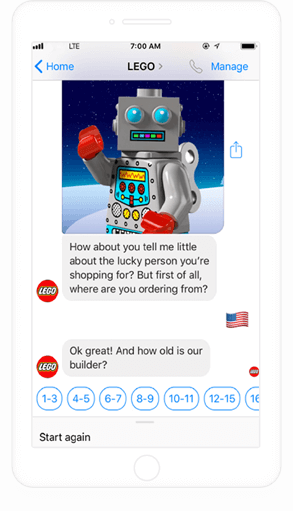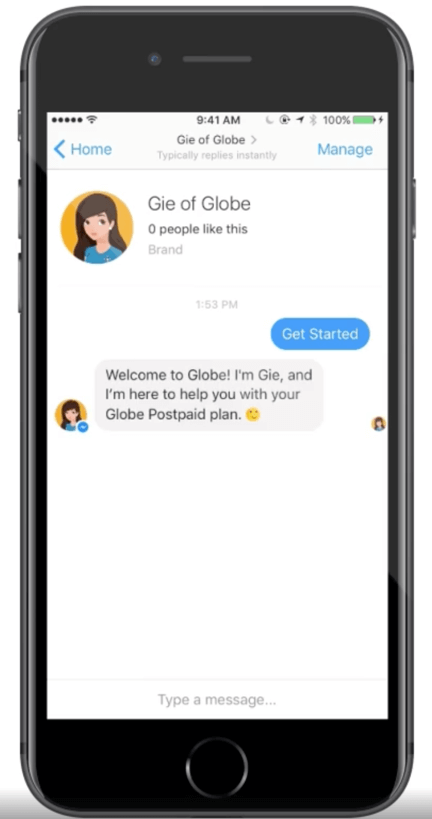In the dynamic realm of modern marketing, the integration of Artificial Intelligence (AI) has emerged as a crucial asset for businesses seeking to secure a competitive edge. This series of blogs delves into the dynamic intersection of AI and marketing strategies, uncovering how intelligent algorithms and machine learning are reshaping the landscape. From crafting personalized customer experiences to facilitating data-driven decision-making, join us as we explore the transformative power of AI in marketing. These articles provide insights and practical applications, catering to both seasoned marketers and those embarking on their digital journey. By demystifying the role of AI, we aim to shed light on its profound impact on the future of marketing.
MintTwist is a Finn Partners agency
Find out how businesses are using chatbots and AI as part of their sales and marketing to create a better customer experience.
Published by
on
Dating back to the 1960s, before the internet, programming and web development, MIT Professor Joseph Weizenbaum created the first ever chatbot. He designed a programme to copy human conversation by pairing scripted responses to text users entered into a computer and thus the chatbot was born.
Becoming more conversational since the early days, Chatbots have revolutionised the customer experience with instant, personalised responses.
Although they still lack some human aspects and the responses are not always perfect, we are able to see how beneficial they can be.
In the past few years we’ve seen an increase in Artificial Intelligence chatbots across social platforms such as Facebook, when it launched bots for messenger in 2016, to voice experiences with smart speakers, such as the Amazon Alexa.
Recently, Google launched Google Assistant, an AI chatbot that extends across the app, smart speakers, smart watches and your computer.
Developers are working to create new consumer experiences and increase the utilisation of chatbots in marketing practices. As innovation continues, chatbots will continue to push boundaries and open new doors.
Let’s take a look at the rise of the chatbots and how they can be used to your benefit.
Messages from chatbots often have higher open and click through rates than traditional email marketing.
Pop-ups can be used to inform and engage users. Bots use sales funnels to segment audiences and sell products.
When a user says ‘no,’ bots can ask why and send the user to a different point in the sales funnel. Which can create the ability for a user to convert at another time.
Chatbots can serve a variety of functions in ecommerce such as notifying shoppers of cart abandonment or recommending products after a purchase.
The personalisation and predictive ability of chatbots allows marketers to build a better connection with a consumer. Chatbots, unlike emails and apps, have a low barrier to entry.
For example, many Facebook users already have the Messenger app, so building a chatbot to work within the platform means the consumer can use the app bot on their own terms. With a good experience it is easy for the bot to contact you and vice versa.
Unlike email, chatbots can be used on a variety of platforms beyond the company site. Social media platforms allow bots to chat with users on a one-on-one basis if the consumer is interested.
Here are some marketers taking advantage of chatbots on Facebook;
Using Facebook Messenger LEGO created Ralph the Gift Bot, a chatbot that provided gift recommendations and transactions in Facebook Messenger’s web-view. To engage with holiday shoppers LEGO ran click-to-Messenger ads on Facebook and Instagram.
Shoppers gave Ralph a bit of info about the person they were shopping for and Ralph suggested gifts they would enjoy.
With Ralph, LEGO’s cost per conversation was 71% cheaper with the ads and saw 3.4x higher return on ad spend when compared to ads that linked to the LEGO website. Due to his success, Ralph is now available year-round.
To pro-launch its new Kia Stinger in Europe, Kia Motors Europe ran a month-long Facebook campaign across 18 European countries.
Kia used three video ads to grab attention in the News Feed and a Messenger bot that could chat with potential customers.
The Kia Bot could help consumers enter a competition to win an experience that was related to the campaign. Click-to-Messenger ads linked consumers directly with the bot allowing for 3,000 contest registrations across Europe.
Chatbots are being used within the customer service space, taking roles that were traditionally performed by a live human on the other side. Now, you can order food, book a flight and get recommendations for almost anything from a chatbot.
Companies can save money by employing chatbots in customer service and sales capacities.
In fact, BI Intelligence estimates that chatbots will save companies billions in annual salaries.
This trend in savings will only increase, as 65% of millennials prefer getting online support in lieu of speaking to in-store staff. The desire for less human connection is growing and businesses are jumping on board.
When using chatbots for customer service there is an 80/20 guideline.
Most of the same questions will be asked 80% of the time and these questions are excellent for chatbots. But, when the chatbot is stumped with a more individual question a human can step in and send a response.
Let’s take a look at some companies using chatbots to offer enhanced customer service.
As one of the largest telecom companies in the Philippines, Globe connects millions of customers. The telecom company needed a way to improve communication without sacrificing its customer service experience.
To communicate with its large customer base in a more personalised way, Globe built a Facebook Messenger bot.
So, Gie of Globe, a young, digital-savvy Filipina was built. Gie was built to be highly relatable to Globe’s customers and smart enough to know when a customer service experience needed an additional human touch.
Gie brought Globe a 22% higher customer satisfaction rate than the call centre, a 3.5x increase in employee productivity and 50% reduction in calls to its customer hotline.
Efficient communication for the win!
Making consumer experience better without sacrificing privacy was a top priority for airline giant KLM.
The airline was aware that its customers were spending a lot of time on Facebook and Messenger, so it made Messenger the ideal platform for a new communication technique.
By placing a ‘send message now’ feature on its Facebook page, KLM increased Facebook messages to its agents. Because of this increase, KLM added AI to Messenger, providing agents with a proposed answer and allowing agents to make necessary tweaks, then send the message.
Messenger is also used to send customers flight information such as; booking confirmations, check-ins, boarding passes and flight updates. Now 15% of online boarding passes are sent via Messenger.
With the likes of LEGO Ralph, Kia Stinger, Gie of Globe and KLM, the evolution of chatbots is just beginning.
The abilities and popularity of chatbots are expected to rise over the next few years increasing engagement, personalising shopping, improving customer service, and ultimately, providing speedy services to consumers.
In the future, bots may even replace websites and mobile apps…
But for now, let’s not get ahead of ourselves.
Are you seeing success with chatbots? Got questions? Let us know! Contact MintTwist today to find out how we can help you.
Created by
Published at
Share this article
More insights from the team
We’re proud to be a digital marketing team of many cultures, beliefs and identities. With from MintTwist Towers in London.
© 2024 MintTwist. All rights reserved. Registered in England and Wales 5261672.




